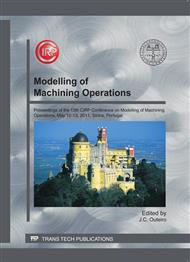[1]
Babuška I., Aziz A., 1976, On the angle condition in the Finite Element Method, SIAM Journal of Numerical Analysis, 13: 214-227.
DOI: 10.1137/0713021
Google Scholar
[2]
Strenkowski, J.S., Carroll, J.T., 1985, A finite element model of orthogonal metal cutting, ASME Journal of Engineering for Industry, 107: 346-354.
DOI: 10.1115/1.3186008
Google Scholar
[3]
Shih, A. J., 1995, Finite element simulation of orthogonal metal cutting, ASME Journal of Engineering for Industry, 117: 84-93.
DOI: 10.1115/1.2803283
Google Scholar
[4]
Strenkowski, J.S., Carroll, J.T., 1986, Finite element models of orthogonal cutting with application to single point diamond turning, International Journal of MechanicalScience, 30: 899-920.
DOI: 10.1016/0020-7403(88)90073-2
Google Scholar
[5]
Rakotomalala, R., Joyot, P., Touratier, M., 1993, Arbitrary Lagrangian-Eulerianthermomechanical finite element model of material cutting, Communications inNumerical Methods in Engineering, 9: 975-987.
DOI: 10.1002/cnm.1640091205
Google Scholar
[6]
Olovsson, L., Nilsson, L., Simonsson, K., 1999, An ALE Formulation for the Solution of Two-Dimensional Metal Cutting Problems, Computers and Structures, 72: 497–507.
DOI: 10.1016/s0045-7949(98)00332-0
Google Scholar
[7]
Belytschko, T., Krongauz, Y., Organ, D., Krysl, P., 1996, Meshless Methods: An Overview and recent developments, Computer Methods in Applied Mechanics and Engineering, 139(1-4): 3-47.
DOI: 10.1016/s0045-7825(96)01078-x
Google Scholar
[8]
Fried, I., 1973, Accuracy and condition of curved (isoparametric) finite elements. Journal of Sound and Vibration, 31: 345-355.
DOI: 10.1016/s0022-460x(73)80278-0
Google Scholar
[9]
Dohrmann, C.R., Heinstein, M.W., Jung, J., Key S.W., Witkowski W.R., 2000, Node-based uniform strain elements for three-node triangular and four-node tetrahedral meshes. International Journal for Numerical Methods in Engineering, 47: 1549–1568.
DOI: 10.1002/(sici)1097-0207(20000330)47:9<1549::aid-nme842>3.0.co;2-k
Google Scholar
[10]
Calamaz, M., Coupard, D. and Girot, F., A new material model for 2D numerical simulation of serrated chip formation when machining titanium alloy Ti–6Al–4V. International Journal of Machine Tools and Manufacture, 48: 275–288.
DOI: 10.1016/j.ijmachtools.2007.10.014
Google Scholar
[11]
Sima, M., Özel, T., 2010, Modified material constitutive models for serrated chip formation simulations and experimental validation in machining of titanium alloy Ti–6Al–4V. International Journal of Machine Tools and Manufacture, 50: 943-960.
DOI: 10.1016/j.ijmachtools.2010.08.004
Google Scholar
[12]
Kalpakjian, S., Schmid, S.R., 2003, Manufacturing processes for engineering materials. IV Ed. Pearson Education, Inc.
Google Scholar
[13]
Edelsbrunner, H., Kirkpatrick, D. G., Seidel, R, 1983, On the shape of a set of points in the plane, IEEE Transactions on Information Theory, IT-29(4): 551-559.
DOI: 10.1109/tit.1983.1056714
Google Scholar


